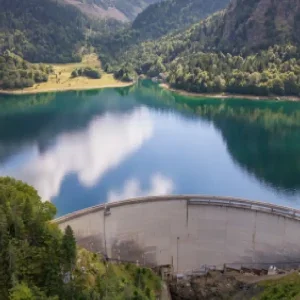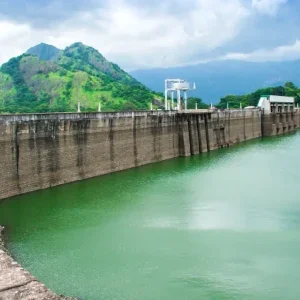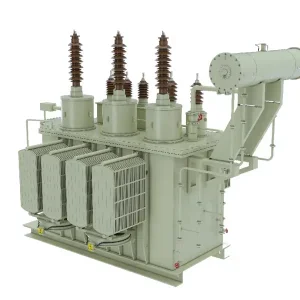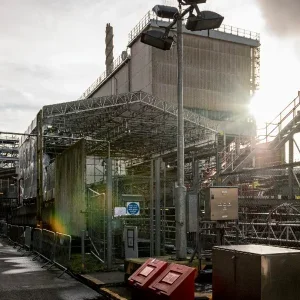Nobody here wants to see their industry die.’ Adrian Lloyd, from engineering company Halcrow Gilbert, spoke for everyone who had gathered at the Confederation of Renewable Energy Association’s (CREA’s) recent conference in London. ‘There are opportunities out there,’ he said. ‘We just have to go and get them.’
Addressing members of the small hydro industry who had gathered with other renewable generators from around the UK, Lloyd was reflecting on government proposals for the future of the renewable power industry. Many plans are still uncertain and were met with mixed emotions as the day unfolded. ‘There are a lot of questions still to be answered here,’ said Alex Tindall from NPower, a UK utility which has 50MW of hydro capacity and aims to develop its portfolio of small hydro schemes. ‘But there is the potential that the proposed policy can deliver what the government wants.’
What the UK government plans to do is replace the Non Fossil Fuel Obligation (NFFO), which has been used as a mechanism to support renewable generation, with a renewable obligation on electricity suppliers that relies on market forces. The government says that the changing structure of the UK energy market has made it necessary to reconsider support for NFFO.
NFFO materialised through the 1989 Electricity Act. The Secretary of State announced NFFO orders, five in total, which gave guidelines about which renewables could qualify. Potential renewable generators then forwarded their expressions of interest to the Non Fossil Purchasing Agency (NFPA) which acts as an energy agency for the regional electricity companies. Competitive bidding took place with generators giving the price at which their renewable electricity could be sold. It was then up to the Department of Trade and Industry to decide who should be awarded NFFO contracts, starting with the lowest bids.
The main attraction of NFFO is that NFPA pays renewable generators a premium price for electricity which is guaranteed throughout the entire length of the contract (usually 15 years). To compensate for the difference between the premium price and market price paid for electricity, the regional electricity companies are paid a percentage of the fossil fuel levy which is financed by consumer electricity sales.
Effectively NFFO insulated renewable generators from market risk. With its 15-year index linked contracts, it also gave assurance to members of the finance community when backing renewable schemes. But now the government is keen to get the renewable power market working for itself. As Helen Liddell, Minister for Energy, said: ‘It’s time to make the next generation of renewables lean and mean, as well as clean and green.’
Describing its determination to put the environment at the heart of its decision making, the UK government says it has committed itself to a new and strong drive towards renewable sources of energy. It wants to achieve targets of ensuring that 5% of UK electricity supplies comprise renewables by 2003, rising to 10% by 2010 and remaining there until at least 2025. In order to reach this goal the government will place a renewable obligation on electricity suppliers, specifying that a set percentage of their electricity must comprise renewables, which excludes hydro power over 10MW.
Electricity suppliers can either meet their obligations by purchasing renewables, or by purchasing green certificates from a supplier which has more than its quota of green power (green certificates are issued for each kWh of renewable power), or paying the buyout price for its shortfall (see panel on p16). The biggest difference between this proposed policy and NFFO is that generators will no longer communicate with NFPA. Renewable generators will have to negotiate their own power purchase agreements (PPAs) directly with electricity suppliers. ‘The world is changing,’ David Fitzgerald, chairman of CREA, said. ‘Before we had NFPA but now we have to get supply companies talking with renewable generators.’
David McKenzie from Garbhaig Hydro Power Company says that it is good to have a greater obligation on the supplier. ‘It is also my belief,’ he said, ‘that, as old NFFO contracts expire, this mechanism has been set up so small renewable generators can play a part in the electricity market.’ But the extent of renewables’ role in this market depends on power purchase agreements and project financing, both of which are a cause for concern for the small hydro industry.
The key element of NFFO was that it offered price security and long term stability for both generators and financiers. ‘The long term contracts gave us the opportunity to write off the capital cost of the scheme over the term of the contract,’ McKenzie says. ‘So when the NFFO contract expired all debt would be paid off, enabling generators to compete in the market with other technologies at a similar price.’
With the new government proposal long term contracts are still needed to encourage new development. Steve Cryer from South West Hydro Group says: ‘We need to secure long term contracts to get financiers to back us. It is so important that hydro has very robust PPAs that will last for a long enough term to allow full repayment to financiers. The ball is very much in the suppliers’ court.’
Concern over the possible reluctance of suppliers to commit to long term PPAs is rooted in uncertainty. ‘Suppliers may be reluctant to give long term power contracts if they believe that market competition will drive prices down,’ Cryer explains. Tindall from NPower goes on to add that suppliers also want to know more about the new policy. ‘They will not want to buy relatively high
priced power if there will be the prospect of trading cheap green certificates worldwide,’ he says. ‘There is also political uncertainty about this policy. As yet there is no confidence that the obligation will remain until 2025 as the government says it will.’
‘Renewable energy does have a degree of uncertainty,’ David Bassett from the British Hydropower Association (BHA) adds. ‘And NFFO provided a prop for us with a 15-year contract. Outside of NFFO I do not believe that suppliers will be able to give long term contracts.’
Without the security of long term contracts hydro’s biggest hurdle is getting finance for new schemes, and this is seen as the greatest weakness of the proposed policy. ‘We understand that banks are risk-adverse and they will set certain conditions,’ Cryer says. ‘So we have got to be able to put something together that will be agreeable to the finance community.’ The hydro community is keen to ensure that it can give the banks what they need.
If suppliers keep overlooking hydro, Cryer says that the industry will have to go back to the government and demand that something be done about it.
Financing projects
Financing renewable projects is at the difficult end of the project finance spectrum, according to Jason Russel from SG Bank. Robust contractual structures are required to cover risk allocation and where there is uncertainty the banks will now want cash. Without NFPA to refer to anymore the finance community will scrutinise the credit quality of contracting suppliers and will demand more equity.
Russel also believes that it will be very difficult to attract finance for low cost, small scale projects. He described it as a laborious task to finance small schemes — just because they are small it does not mean that they incur less work or less cost for financiers. He believes that anything below £15M will not attract finance. ‘Perhaps I am being too negative,’ Russel said, ‘but as a banker, words such as uncertain and unknown, make me nervous.’
Godfrey Bevan from the DTI was quick to point out that initially the financial community was reluctant to support NFFO but gradually it did embrace the idea. As the banks became more familiar with NFFO they became more confident in their deals.
‘The banks were unsure about NFFO to start with,’ Cryer says. ‘They wondered how they would get their money back and as a lot of schemes weren’t built there were no performance measures. But some NFFO schemes have proved to be very successful and may give the banks confidence that renewables can
deliver. It will hopefully assure them that hydro is a sound technology without any surprises.’
Russel agreed, saying that once track records have been established under the new regime finance will follow. ‘Yes the first days of NFFO were also difficult,’
he said, ‘but one thing is for sure — things are not going to be as good as they have been.’
Minister for Energy, Helen Liddell, does not appear to agree with Russel. ‘A market-based approach is designed to attract investment and will give industry the confidence to develop renewables much faster than at present,’ she said.
Initially members of the small hydro industry were pessimistic about the prospects for financing new hydro schemes. It was felt that perhaps NFFO has cushioned the industry and given it an artificial perspective of the power market. However David Bassett from BHA believes that it will still be possible to secure finance, and members of the UK hydro industry are already looking to European banks for support.
‘The Dutch bank Triodoss, which has financed some small hydro schemes in Manchester,’ Bassett said, ‘offers renewable generators favourable loan agreements. UK banks do not offer the same terms.’ Indeed BHA is making its members aware of such international banks when seeking project finance. ‘Perhaps it is due to the fact that these banks have more experience of renewables in Europe,’ Cryer said. ‘And this makes them more knowledgeable and receptive to the idea.’
High construction costs
The main problem with financing hydro is that it is disadvantaged by its initial construction costs — Cryer estimates that it now costs about £1200 per kW of hydro. A lot of small hydro in the UK comprises family-run businesses and, if collateral requirements rise, many of these will not be able to put up the necessary finance for new developments. In comparison, Bassett believes that electricity supply companies with their own hydro generation will have the advantage in this new policy. They will not need to secure finance and can develop hydro to fulfil their own renewable obligation.
‘Finance will not be so much of an issue for Npower,’ Alex Tindall admits. ‘We will have the ability to balance our sheet finance and, as part of an electricity company, having our own renewable generation will help us meet our obligations. Of course we will still have to meet our renewable obligation in an economic manner,’ he added, ‘but contract negotiations will only be a small concern for us.’
In comparison Cryer says that it is a new concept for small hydro generators to negotiate power supply contracts. ‘Before you didn’t negotiate with NFPA but just made a bid. You didn’t have anyone trying to change the condition of your bid, as they will with contracts,’ he said. ‘Negotiations with the suppliers will depend on how much of their renewable obligation has been met, how much they want to pay for electricity and how many customers they have signed up to supply renewable energy with. It will be harder for the smaller organisations who have one or two sites, and BHA may need to offer advice or guidelines to its members. The larger organisations will definitely have the greater bargaining power.’
Amalgamation
The short term future under the government’s proposed policy seems to point to amalgamation and aggregation within the hydro industry, particularly for PPAs for existing schemes. ‘We will probably see a more co-operative approach to hydro,’ Cryer said. ‘The grouping together of existing schemes to sell energy will put them in a stronger position.’
McKenzie strongly believes that a collective approach is more advantageous than individual efforts when selling hydro. He is the chairman of Alba Energy in Scotland, a group of 17 small hydro generators who joined together 18 months ago. After SRO contracts (the NFFO equivalent in Scotland) had expired, the generators were having little success in securing individual PPAs.
‘Undoubtedly a collective voice is more effective,’ McKenzie says. ‘We established Alba as we knew that by combining our output we stood a better chance of attracting suppliers. We have had some success and are hopeful for the future.
‘There are obviously some costs involved with running a collective but there are no major disadvantages in small generators joining together,’ he added.
Npower is also quietly confident about the new proposal. ‘I believe that this is a genuine attempt by the government to show how it will meet its own renewable targets. We see this as a positive thing. We’re excited and look to grow based on it,’ Tindall said.
NPower believes it may also be able to help others develop small hydro sites. ‘On the back of the government’s proposed mechanism we’re looking at a lot of development,’ Tindall explained. ‘We cannot undertake all of this ourselves and so are looking to harness the skills of other hydro developers. If the issue of financing and contracts becomes a major problem with this policy they may welcome the work.’
Tindall adds that the hydro industry needs to look at the positive aspects of the government’s proposal. ‘NFFO was not perfect by a long way,’ he says, and other members of the hydro industry agree. NFFO had its faults and did not always look at hydro favourably (see panel below).
‘Without NFFO or the proposed renewable obligation the fence is too high for hydro to scale,’ Cryer says, ‘and many people will not bother to venture down the hydro route. There is a glimmer of hope with this new policy and I think we can move forward as an industry. Yes, there will be problems, but I believe we will see more hydro power developed in the UK.’
| The renewable obligation |
The government’s proposed renewable obligation has yet to be finalised and is open to consultation. This may take some time and concrete developments are not expected for at least 18 months. Minister for Energy, Helen Liddell, has asked renewable generators throughout the UK to respond positively to ‘this climate of opportunity’. To fulfil their renewable obligation electricity supply companies will have to provide a set percentage of their power from renewable sources. They can do this by: Purchasing renewable energy from generators through normal PPA negotiations. Purchasing green certificates from a supplier which has more than its quota of renewable energy available. A green certificate will be issued for each kWh of energy generated from a qualifying renewable source. This can be sold separately from the physical energy into the tradable green certificates market. The disadvantage of green certificates may be European or worldwide trading. It is unclear yet whether this will happen but the UK hydro industry feels if it does it will not encourage the development of new plants in the UK. The Environment Agency, which regulates UK hydro, is accused of having an anti-hydro culture while the industry’s European colleagues are seen to be encouraged and supported by their governments. Paying a fine called the buyout price if they fail to meet the renewable obligation. This is effectively a mechanism to remedy the situation if there is insufficient renewable energy to meet demands. The DTI says it is looking to cap the buyout price at 2p per kWh (the price that will be paid for green power over and above the price for fossil fuel). |
| Unanswered questions |
Existing NFFO contracts: There are many unanswered questions related to the government’s renewable obligation. One concern is what will happen to existing NFFO contracts. The government says it is committed to ensuring the integrity of these as it is important to maintain investor confidence. But how this will be done remains to be seen. Currently the Confederation of Renewable Energy Associations is in discussion with the Non Fossil Purchasing Agency and the Department of Trade and Industry. Alex Tindall from NPower says: ‘It will be a complex process to honour existing NFFO contracts but the government has said it will. If the government turns its back on its promise, confidence in the new mechanism will be severely affected. Projects will be difficult to finance as the investment community will see that the government says one thing but does another, and so they will never believe in them again.’ ‘There is uncertainty at the present time for those with existing NFFO contracts,’ says David Bassett from the British Hydropower Association. ‘But in a way we have bitten the bullet. We have put faith in the government and taken it at its word that it will honour NFFO and that NFFO’s replacement will bring us the same benefits.’ A matter of price: Another concern for the hydro industry is the price at which it can sell its power. Hydro is not a low cost renewable such as landfill gas, and a small hydro scheme does not have the economies of scale of a 30MW wind farm. Indications are that the buyout price will be capped at 2p/kWh (or approximately 4p per unit. See price breakdown). But this is not certain and hydro will have problems getting below the 4p mark. ‘There is the question of the buyout price,’ Alex Tindall from NPower says. ‘The government says that it will be 2p/kWh but we’re not sure if this is inflation proof and so on. It also initially said that the climate change levy would be 0.6p/kWh but this has now dropped to 0.43p/kWh.’ ‘Hydro power cannot fall below a certain price,’ says Steve Cryer from South West Water Hydro. ‘It is very difficult for us to break the 4p barrier. This is critical and will not change.’ David Bassett from BHA agrees, saying that people will struggle to get below 4p. Hydro prices in NFFO ranged from 3.85-4.3p/kWh. But hydro had the highest prices in NFFO 5. The Minister for Energy has said that the choice of renewable technology is for the market and not the government to decide. She has said that it may back the development of currently expensive technologies, such as offshore wind and energy crops, so that they can make a greater and more economical contribution in future, but no mention was made of small hydro. ‘The problem hydro faces,’ says David McKenzie from Garbhaig Hydro Power Company, ‘is that it is a known technology that cannot drastically reduce its costs from current levels.’ The price of renewable energy (to generator from supplier): Total 3.9-4.2p (Compiled by BHA and National Wind Power) |
| The disadvantages of NFFO |
NFFO rounds only happened when the DTI wanted them to. There was no set schedule and this made it difficult for companies to make business plans. NFFO has been described as a tedious process. It would take a year or more before announcements were made about successful bids. This made it difficult for companies to carry out preliminary studies etc. An unsuccessful bid would mean wasted time and money. Competitive bidding meant that NFFO was always pushing power prices down. Whoever put in the lowest bid got the contract. This meant some NFFO/SRO projects were awarded at prices that could never be developed. Consequently some sensible projects were blocked. Only allowing one project to a NFFO award was described as frustrating. Two sites could be developed economically on one NFFO award. As only one could be developed this often meant neither were. The hydro industry feels that NFFO did not look upon hydro favourably. NFPA said it was very difficult to include hydro in NFFO rounds as it was not able to get close to the market price for electricity. NFPA wanted to exclude hydro from NFFO 5 as its prices had not fallen as other technologies’ had (see bar chart). Anyone could theoretically apply for a NFFO award. Only a vague right to build on proposed project land was required. This sometimes meant that two NFFO projects were awarded for the same site. It also caused problems in some local communities. Planning permission was not required until after the NFFO award and many local communities did not know about proposed developments until a later date. |






